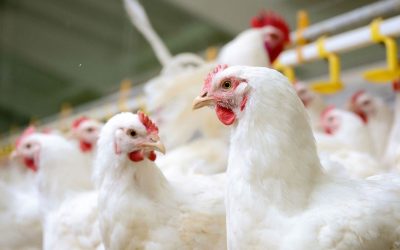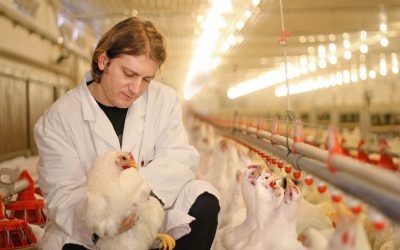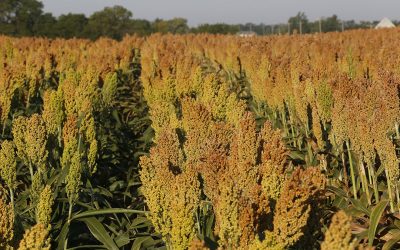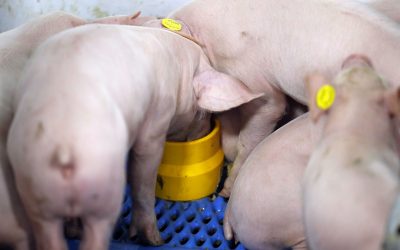Nutrigenetics and nutrigenomics: Potential for feed

For many years, genetic selection has been conducted on the basis that the genotype of an animal determines its productivity for a particular trait, for instance milk production or growth. However, recent evidence suggests that it is not only the presence of specific genes that makes an animal more productive, but also which genes are actively expressed or not.
Gene expression is affected by numerous environmental factors, of which nutrients play a central role. The interaction between nutrition and genes is a new area of research that may change the future of nutrition in humans and animals.
Describing the terminology
This interaction can be defined by two main fields of study: Nutrigenetics, the study of how various genotypes respond differently to a particular nutrient and Nutrigenomics, the study of the effect of nutrients on gene expression. By studying the genetic variation among animals, nutrigenetics may identify specific markers for the selection of animals able to respond in a positive way to a particular nutrient, thus, for instance, becoming more efficient. Conversely, in nutrigenomics researchers study the direct interaction between a particular nutrient or molecule and gene expression, which may allow selective directing metabolism towards a particular function. The modification of gene expression as a result of environmental influences is defined as epigenetics. Epigenetics is the study of changes in gene expression without affecting the deoxyribonucleic acid (DNA) sequence. That is to say changes to the phenotype without affecting the genotype. Differential expression of genes is a natural process. For instance, all cells of one individual have the same genetic makeup, but the various results lie in the different local environments. Mammary cells, for instance, are different to liver cells.
External factors
However, in addition to this programmed cell differentiation, gene expression can also be affected by a number of external factors, such as age, environment, diet, diseases, etc. This selective expression is mediated by different mechanisms, including DNA methylation and acetylation, histone modification and non-coding ribonucleic acid (RNA), among others. These modifications act as tags that may either increase or decrease the expression of particular genes, and therefore modify the functionality of specific metabolic pathways. The exciting, and at the same time challenging, nature of epigenetics is that these tags are not genetically predetermined, but can change in response to external signals, making the phenotype flexible in response to outside influences despite the fact that it may be a more conserved genotype.
Research examples
As we aim to better understand the mechanisms involved in selective modulation of key genes of specific metabolic pathways, and the potential effect of nutrients on this regulation, we may be able to identify new opportunities for designing diets to improve production performance. Here are some examples of how the understanding of nutrigenetics and nutrigenomics may transform our nutritional strategies for livestock.
Example 1: Chicks
Lillehoj et al. (2011) supplemented chick diets with different essential oils, containing cinnamaldehyde and capsicum oleoresin, from one day post-hatch, and then challenged them with E. acervulina. These essential oils significantly reduced the infection rate and improved bodyweight gain.
However, the fascinating finding was that the expression of genes involved in metabolism and immunity were modified. For instance, cinnamaldehyde modified the expression of genes related to antigen presentation, humoral immune response, and inflammation, representing an interesting example of the potential of using specific additives to modulate gene expression (nutrigenomics).
Example 2: Calves
Calf feeding strategies in early life has been shown to have a long-term effect on production performance. Faber et al. (2005) reported an increase in milk production in the first and second lactation of cows that were fed different quantities of colostrum in their first day of life (2 vs 4ℓ/d), with the rest of their lives being subject to similar feeding conditions. Other authors have also indicated that an increase in growth rate during the pre-weaning period results in an improved lactation performance of roughly 500 to 700ℓ in the first lactation, representing approximately a 10% increase in performance (Van Ambourgh et al., 2011; Bach, 2011). Such a long-term effect of a relatively short feeding period early in life can only be explained by an epigenetic change (‘imprinting’) occurring in early life, and represents yet another practical example of the potential use of nutrigenomics in improving animal performance.
Example 3: Cows
A recent study by the Autonomous University of Barcelona was conducted to investigate the interaction between milk fat depression induced by feeding polyunsaturated fatty acids (FAs) and gene expression. After conducting a lactation study using linseed to produce omega-3-enriched milk, it was observed that milk fat was strongly reduced in cows fed linseed, as expected. This inhibition of milk fat synthesis has been related to a co-ordinated repression of several genes and gene regulators involved in de novo FA and triglyceride (TG) synthesis. However, after reviewing the milk fat content of individual cows after being switched from a control to a linseed-supplemented diet, it came to light that in certain cows, milk fat content was reduced by more than a one percentage unit (sensitive cows, where milk fat content decreased from 3,87 to 2,52%), while others were able to maintain milk fat content (resistant cows, where milk fat changed from 4,06 to 3,90%). Genomic analyses were conducted in these cows to identify which genes were differentially expressed in sensitive and resistant cows fed linseed, and around 100 differently expressed pathways were found in resistant cows fed the linseed diet compared to resistant cows fed the control diet, while only 13 pathways were discovered to be differently expressed in sensitive cows fed the linseed diet compared to the same cows fed the control diet.
Results suggest that in resistant cows, a compensatory metabolic pathway was activated to increase FA synthesis in the linseed-rich diets. These results indicate that certain nutrients may alter specific metabolic pathways, representing an additional example of the potential use of nutrigenomics to enhance animal performance. In addition, analyses of key gene regulators also allowed the detection of 15 differently expressed genes harbouring single nucleotide polymorphisms (SNPs) which could differentiate between resistant and sensitive cows, presenting the opportunity for identifying genetic markers that would allow for the selection of animals resistant to milk fat depression (nutrigenetics).
More efficient animal production
The study of the variability in response of cows to particular nutrients (nutrigenetics) is an excellent tool to take genetic selection into a new era. While in human nutrition nutrigenetics may evolve into the possibility of designing personalised nutritional programmes, it may be used to reduce animal variation in respect of specific nutritional programmes in livestock production. Furthermore, nutrigenomics is becoming a tool that will support the development of new nutritional programmes and additives which will modulate gene expression in favour of more efficient animal production. Therefore, the role of diet formulation may be expanded beyond that of merely balancing nutrient requirements and supplies, and will require the inclusion of specific nutrients due to their non-nutritional genomic characteristics.
This article has been reprinted from AFMA Matrix, October 2016.











